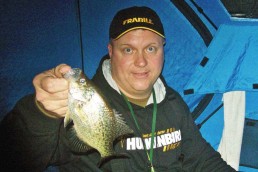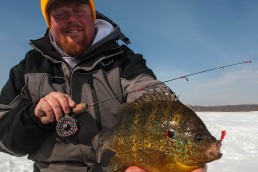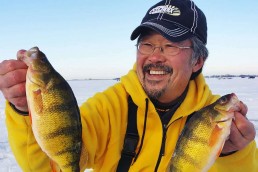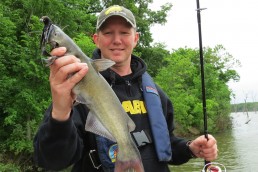Stay Out on Ice after Dark for Great Crappie Action
SHARE THIS POST
I was staring at my depthfinder, watching the jig and waxworm hovering above a stubborn fish hanging just off the bottom in 22 feet of water. The fish—most likely a bluegill—settled back to the bottom without taking my bait. I noticed a heavy mark appear on the Humminbird 9 feet up from the bottom. As I slowly reeled my bait up toward the mark, another mark appeared 5 feet off the bottom, and almost immediately my float, suspending a crappie minnow 5 feet off the floor, headed down the hole. I dropped my jig rod, grabbed the float rod and reeled in a 10-inch crappie. As I dropped the crappie back into the hole, I noticed three strong marks on the flasher from 6 to 10 feet off the bottom. I scurried to get another minnow down under the float and get my jig rod going. The sun had set, the bluegills had stopped and now the crappies were on the move—this was what I had been waiting for.
This is a common occurrence during the ice period of January and February. Crappies become very nocturnal, and to consistently catch numbers of them, you may need to stay out after dark. This can seem intimidating to some at first, but ice fishing for crappies after sunset is both relaxing and rewarding. Many leave the lake after dark, so it can be very quiet out on the ice. The crappie fishing can be outstanding if you are on a lake with a good population, you are in the “right spot” and the weather is relatively stable. The right spot can vary depending on what your lake has to offer. I like to look for offshore humps, bars, reefs and main-lake points. Deep basins with a soft bottom should border these locations. The humps, reefs, and points are easy to find with a GPS, and can also have fish houses all over them. If these humps and points have weeds on them, they are good spots to catch sunfish and pike during the day, and are usually quite busy. I like to set up over the deep, soft-bottomed basin area adjacent to the shallower, weedy area. Crappies will suspend over the basin area, often close to the depth that the hump or reef comes up to, and feed on various kinds of larvae and worms rising up out of the soft bottom after dark. If you turn up the gain or intensity on your flasher, you can actually see the food in the water. The fish are moving around as the food rises in different areas of the basin, and even move onto the adjacent shallow areas to look for minnows. Due to this constant movement, your fish will often come in spurts with lulls in between. You have to get re-baited and back down quickly during the spurts to catch as many fish from a moving school as you can, and you will have to be patient during the lulls.
Equipment for this type of fishing is fairly basic. You can sit outside if it is warm enough for the holes to stay open and not too windy, but a portable shelter is good too. Either way, you can move quickly to another part of the basin you are fishing or to another spot altogether if you are not seeing fish and food on your flasher. A portable shelter, like my Clam Fish Trap Voyageur XLT, allows you to fire up a heater, be sheltered from the wind and still move if necessary. I can pull my Fish Trap out onto the lake behind a snowmobile or ATV, and move from spot to spot. I can also haul it out onto the lake in my pickup bed if the ice is thick enough, and then pull it behind my truck from spot to spot once on the lake. I drill holes in multiple locations over the basin area I am targeting before sunset. If my partner and I are using a portable shelter, I drill the holes in clusters that fit in the shelter. The key is to be able to move and search. You will want some type of lantern, either electric or propane, and a headlight for baiting up and unhooking fish. A good ice fishing sonar is a must, as the fish will often not be near the bottom, so you can’t just use the bottom to determine where to fish. As mentioned, my Humminbird 688 ci HD shows me fish and larvae throughout the water column, and even helps me find fishing spots, as it is also a mapping GPS unit compatible with Lakemaster Humminbird charts. Each angler should have two ultralight jigging rods: one rigged with a vertical jig or spoon, and one with a horizontal jig to present the bait in different ways. If the fish are very active, I like to tip jigs and spoons with small softbaits, like a Berkley Gulp 1-inch Fish Fry. If the fish are finicky, go with waxworms or euro larvae.
Each angler should also have a deadstick or float rod for their second line, only if a second line is permitted where you fish. I like to rig these rods with a vertical, glow-in-the-dark jig tipped with a small crappie minnow. You will want a lantern by your second hole to watch the rod tip on the deadstick or the float in the hole for bites.
Are you enjoying this post?
You can be among the first to get the latest info on where to go, what to use and how to use it!
Watch your flasher and move your jig to fish that show up. Jig it just above the fish until it reacts and moves up. Then hold the bait still until the fish takes it or starts to move away. Their reactions will show on the sonar if they want the bait or keep moving. Crappie bites can be very light. You must watch the rod tip closely when a fish is on the sonar looking at your bait. I like to keep the line on my index finger, much like fishing a live bait rig in the summer, but with the bail on the reel closed so I can feel a bite. A spring bobber can be very helpful in detecting light bites. Often, a crappie swims up under the bait and lightly closes its mouth around the bait and just sits there. If you are watching your rod tip or spring bobber closely, this subtle bite will cause the slight bend in your rod tip or the spring bobber caused by the weight of your jig to straighten out from the fish, removing the weight of the jig. It can be that subtle, so you have to pay attention and set the hook the instant you see or feel any change in your offering. You will be watching for the same “negative bite” on your deadstick rod, and if you fish your second line with a float, the float may lift up higher in the water than it normally sits, or even tip on its side from this light bite—get him quick. Start out with your second, stationary line set about 4 to 6 feet off the bottom, and if you notice a depth where fish are regularly showing up on your sonar, move the minnow to that depth. Occasionally, the fish will bite more aggressively. I have had nights where I am reeling in a crappie that hammered my jig, only to look over and see my float out the bottom of the hole and still going. It can be mayhem if a school of active crappies swims into your baits, but it is fun mayhem to say the least.
Don’t follow others off the ice at dark during the mid-winter months. If you have nothing else to do at home, once the sun sets, consider staying out on the ice and experiencing some peace and quiet, along with good crappie fishing. You will catch the occasional bluegill after dark, and the ones you do catch will be big. Your second rod with a crappie minnow may catch you a walleye from time to time as well—you just never know. This technique is both relaxing and rewarding. Give it a try.
Troy Smutka is a central Minnesota fishing guide (greatdayonthewater.com) and a walleye tournament angler. Troy is also a member of the Lund Boats, Mercury Outboards and Johnson Outdoors Pro Teams.
MWO
SHARE THIS POST
Did you enjoy this post?
You can be among the first to get the latest info on where to go, what to use and how to use it!
Troy Smutka
Troy Smutka is a central Minnesota fishing guide (greatdayonthewater.com) and a walleye tournament angler. He is also a member of the Lund Boats, Mercury Outboards and Johnson Outdoors Pro Teams, and hosts and produces Fishing and Hunting the North Country on YouTube.



